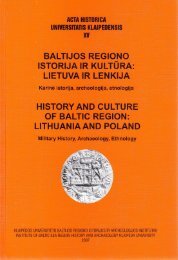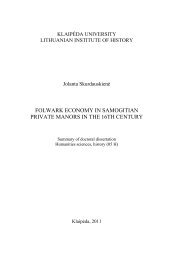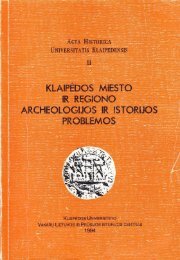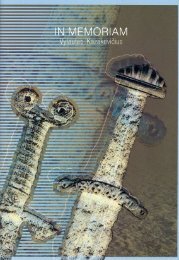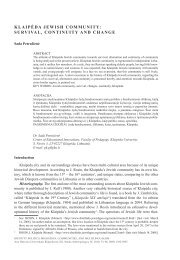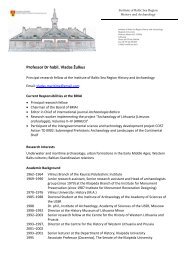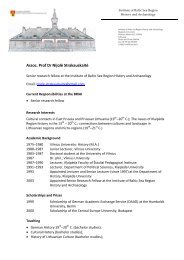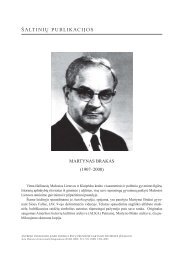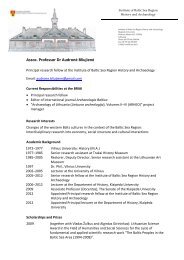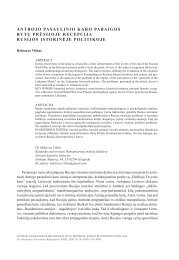university of klaipėda lithuanian institute of history roman širouchov ...
university of klaipėda lithuanian institute of history roman širouchov ...
university of klaipėda lithuanian institute of history roman širouchov ...
You also want an ePaper? Increase the reach of your titles
YUMPU automatically turns print PDFs into web optimized ePapers that Google loves.
36<br />
a, Curonians never used to bury their dead together with horses<br />
and spend less resource on ceremony with equestrian elements. The<br />
status <strong>of</strong> horsemen is <strong>of</strong>ten related to a warrior in South Curonian<br />
cemeteries, inlike Prussians, that used to bury their society members<br />
,and not only warriors, with horses much more <strong>of</strong>ten. This is connected<br />
to a rise in role <strong>of</strong> a horse in Prussian everyday and after-life.<br />
b. Comparing Curonian collective cremations graves <strong>of</strong> several<br />
individuals, erected in vast pits and probably at once, with Prussian<br />
cremations <strong>of</strong> so-named “Achenplätze”, we came to conclusion, that<br />
despite the difference in origin <strong>of</strong> their funeral rituals, cremation graves<br />
with huge concentrations on certain plots <strong>of</strong> cemeteries appear on the<br />
boarder <strong>of</strong> the 11 th -12 th centuries under similar social conditions – the<br />
emergence <strong>of</strong> certain groups like warrior elite or some influential clans,<br />
which carried out administrative functions in certain areas.<br />
c. The first difficulty emerged comparing Prussian and<br />
Curonian supposed women's cremation graves <strong>of</strong> the 11 th - beginning <strong>of</strong><br />
the 13 th centuries, is that such investigation and classifications was<br />
never made for Prussians’ ones. Thus, after analysis <strong>of</strong> several hun-<br />
dreds <strong>of</strong> burials from 5 Prussian cemeteries <strong>of</strong> the period there were<br />
found at least 5 - 15% <strong>of</strong> graves that could belong to women. Compar-<br />
ing this number with 20% on average <strong>of</strong> Curonians, we found out that<br />
no single cremation grave with definite features <strong>of</strong> burial rite or set <strong>of</strong><br />
ornaments <strong>of</strong> Curonian type occurred in Prussian cemeteries.<br />
- Irrespective <strong>of</strong> well-known V. Kulakov theory about the<br />
Curonian colonisation <strong>of</strong> Northern Prussian to be in post-Viking Age,<br />
there were not any certain cremation or inhumation grave <strong>of</strong> Curonian



